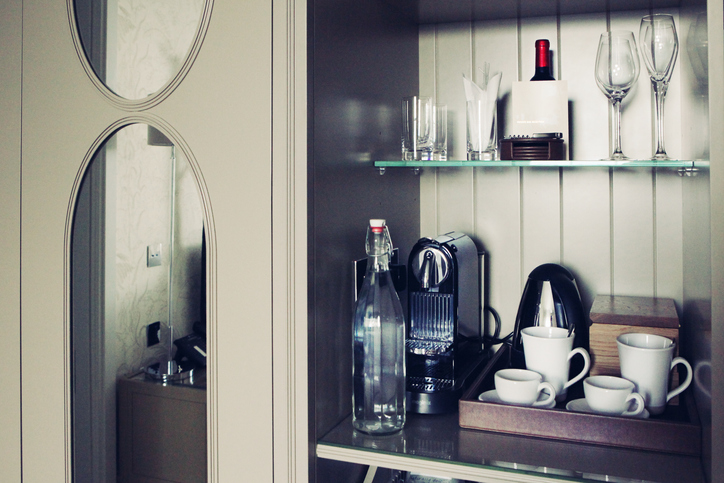
By Larry and Adam Mogelonsky
The minibar is not a guestroom amenity set in stone. In fact, there are ways to use it either to boost total revenues per guest or to help craft an even better hotel experience.
First consider minibar technology. You can buy configurations that automatically debit the guest when an item is removed. This saves labor as it eliminates the need for physical review, automatically orders replacement product and syncs with accounting for guest billing. You can even hire out your minibars to third party services that will manage the entire process on your behalf.
Thinking broader, the minibar remains a thorn in many guests’ sides due to exorbitant pricing. Paying $8 for a bottle of water or $10 for a small chocolate bar just doesn’t bode well with most folks. Why?
It’s seen as extortive because the prices are easily comparable to those in the nearby supermarket. While humans naturally have trouble computing and rationalizing large numbers or relational figures (which explains why fractions are often more emotionally impactful than percentages), it isn’t a stretch of the mental math to discern that a $8 water bottle is roughly four to five times above its retail selling price at the Walgreens two blocks away.
The average guest doesn’t have access to STR data to get a sense of how far above the ADR index for that market area they are paying. But the $8 bottle of water is such a blatant overcharge that it may cause an individual to start to question every other price from the perspective of being ripped off. Above all, it doesn’t reinforce a positive brand relationship.
On a trip to Europe this past summer during the high tides of travel recovery, we stayed in two luxury properties, with rates pushing four figures (converted to USD) nightly. In both cases, the minibars were well-stocked and totally complimentary. This included all beverages (alcoholic and not) as well as snacks.
Undoubtedly the projected cost was built into the ADR. But what was most surprising was that, according to both GMs, the minibar utilization was about the same as when they were charging for the goods. While these were five-star hotels, it reflects a confidence in the guests by those hoteliers and an air of congeniality.
Star ratings and being able to bake average utilization into the nightly rates aside, there are still other reasons to consider eliminating paywalls on your minibar. When acting as asset managers for a West Coast resort a few years ago, we stocked the room fridges with local healthy snacks and soft drinks from a nearby bottler at no charge to the guest. Though the ‘no charge’ decision was primarily logistical because it was difficult for us to provide room service throughout the rural property, it led to some very positive guest feedback and TripAdvisor comments.
At the select-service level, minibars and room fridges may not be part of the value equation. Here, the trend is to have a full-size glass-door, refrigerator unit at or near the front desk. Performing the same function as a smaller unit in each guestroom, this communal amenity typically provides ready-to-eat snacks and cold beverages, admittedly non-alcoholic. While some properties offer access free of charge, others reflect near-retail selling prices, adding it on to the tab manually (easily done as the front desk is next door).
If you are still a traditionalist when it comes to minibar management, perhaps you should look at the full spectrum of costs and benefits associated with this service. This would include the labor, management, accounting, procurement and, significantly, the impact on ratings or advocacy that guests give to your property.
It’s this last part that begs unpacking. An unexpected and value-added minibar experience can boost loyalty, TripAdvisor reviews (potentially offsetting other slights), word of mouth and local partnerships. Holding nightly rates equal versus your comp set, the ‘free minibar’ service gives guests a clear benefit to book your brand over others.
What we are emphasizing through these two five-star property examples is that the gratis minibar offers a highly positive surprise to reinforce an even better onsite experience. When you do the full computation that incorporates variable costs such as labor, software, hardware, maintenance and average guest utilization versus the long-term increases to your brand equity, you may find that rethinking your minibar can be far greater of a revenue generator by being free than as a marked-up charge for each item consumed.


